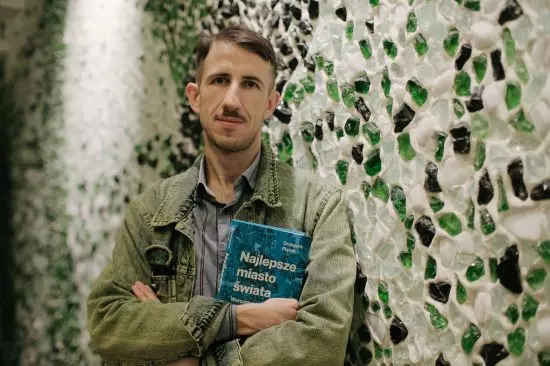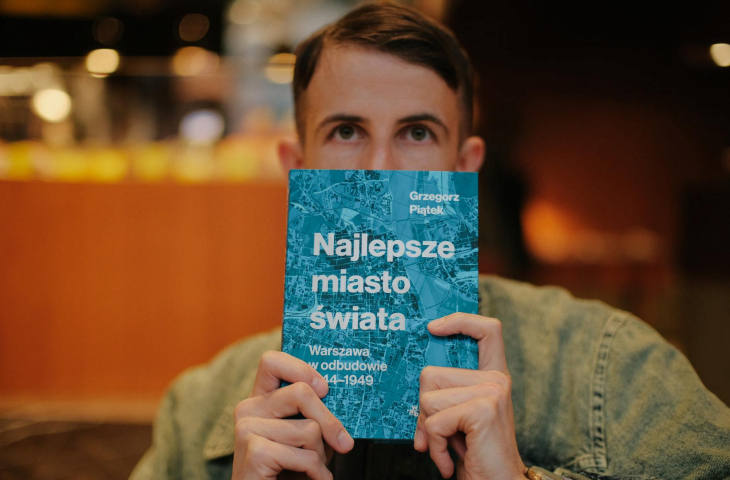Among the seven finalists nominated for the most important Polish literary award "Nike" 2021 was Grzegorz Piątek, historian and architecture critic, author of the reportage "The best city in the world, published last year . Warsaw in reconstruction 1944-1949". Congratulations!



Grzegorz Piątek with a book
Photo: Jakub Celej © W.A.B Publishing House
Funded by Gazeta Wyborcza and the Agora Foundation, the "Nike" Literary Prize has been awarded since 1997, honoring the best book written in any literary genre and published in the year preceding the prize. Winners receive a statuette inspired by the mythical goddess of victory Nike, designed by sculptor Gustaw Zemla, and a cash prize. The award has so far been given to Czeslaw Milosz, Jerzy Pilch, Dorota Maslowska, Olga Tokarczuk (twice), Joanna Bator, Cezary Lazarewicz, Marcin Wicha and Mariusz Szczygiel, among others. The winner of this year's 25th edition of "Nike" will be announced on October 3 this year. The winner will be chosen by a jury chaired by Inga Iwasiów and composed of Teresa Bogucka, Przemysław Czapliński, Maryla Hopfinger, Dariusz Kosiński, Iwona Kurz, Tadeusz Nyczek, Magdalena Piekara and Szymon Rudnicki. The Readers' Nike will also be awarded - you can vote for your favorite here.
In addition to Grzegorz Piątek, those competing for the award will be Kasper Bajon (author of the reportage "Fuerte"), Krzysztof Fedorowicz (nominated for his novel "Afterworld"), Aleksandra Lipczak (for the reportage "Lajla znaczy noc"), Jacek Podsiadło (author of the volume of poems "Double Pendulum"), Zbigniew Rokita (for the reportage "Kajś") and Monika Śliwińska (for the biographical book "Panny z Wesela. The Mikołajczyk sisters and their world").
Published by the W.A.B. publishing house, Grzegorz Piątek's reportage is not only a story about the post-war reconstruction of the capital, but also, as Błażej Ciarkowski writes in his review, a book-monument, a monument to those who undertook the impossible. You can find a full review of the reportage nominated for this year's Nike award below, and an excerpt in last year's May issue of A&B.
compiled by Ola Kloc
More than a book
"The World's Best City. Warsaw in reconstruction 1944-1949" - review
The review appeared in A&B 5'2020
A Polish Fiat 1100 glides down Marszalkowska Street. The afternoon sun reflects in the glass walls of skyscrapers and the rays fall on the face of the middle-aged man sitting behind the wheel The car passes the new train station and the buildings of the government district. It's 1955, and Marian Spychalskiis sitting behind the wheel . He admires the rebuilt Warsaw - "the best city in the world."
Grzegorz Piątek has created an extraordinarily artistic vision of Warsaw rebuilt according to the boldest concepts of the "staff of madmen storming thesky" - architects and urban planners from the Bureau of Capital Reconstruction. A vision that, as he himself wrote, "couldn't happen."



"The World's Best City. Warsaw in reconstruction 1944-1949"
photo: Jakub Celej © W.A.B Publishing House
Paris of the North?
The book "The Best City in the World. Warsaw in reconstruction1944-1949" begins with a journey to the beginning of the 20th century. It builds apicture of a city that is far from the "Paris of theNorth," a picture that apologists of the Second Polish Republic want to see. For them, interwar Warsaw is the elegant storefronts of the Jabłkowsky Brothers Department Store, theWedel House or Adria on Moniuszki Street. For Alfred Lauterbach ,cited by Friday ,it is "an object of civic concern and righteous anger." Active in the Society for the Care of Monuments of thePast, the art historian and restorer was not alone in his critical assessment of reality .
As early as the 1890s, Boleslaw Prus wrote of Warsaw buildings that each " regardlessof the number of stories and the number of windows, is like two drops of water similar to its neighbors: primarily because it is impossible to look at it without distaste"¹. With the restoration of independence ,although the number of problems facing the capital did not diminish, but at least therewere real opportunities to solve them. Stefan Żeromski grumbled that instead of sparkling with rows of glass houses, Warsaw "still looks like a provincial town oftsarist satrapy." Architects and urban planners, politicians and activists floated dreams of a new and better Warsaw. They drew wide arteries and squares surrounded by new edifices. Mock-upsand sketches depicted the capital of a country aspiring to become a modern superpower.
"A sect of dreamers"
Without a critical look at interwar Warsaw and listening to the voices of those who, like Lauterbach, advocated extensive modernization of the city, it is impossibleto properly assess the postwar activities of theCapital Reconstruction Bureau. "A sect of dreamers," as the Warsaw street maliciously called them, gathered in a building on Chocimska Street wanted to "correct the mistakes of the twentieth century." Their enthusiasm meant that, looking far into thefuture, they often overlooked what was happening here and now.
Fascinated by the achievements of the architectural avant-garde of the West, they were unwilling (or unable) to see that postwar Poland was not only a poor country with very limited productive capacity, but also a conservative one."Or perhaps unconscious elitism was toblame for the failure of thefirst plans," he says. -ponders Piątek, juxtaposing Bierut's concept of "workers in the inner city" with the visions of the Warsaw Urban Complex . The designers committed a common sin of idealists. They felt that it was up to society to grow up with their concepts, instead of adapting them to popular expectations. Just as Soviet Constructivism remained "the great intellectual adventure and fascination of theMoscow or Pyotrgodovintelligentsia "², Warsaw's "glass houses" were a continuation of pre-war fantasies about the city.
past and present
Friday writes about the past, but stories from decades ago often reflect the problems architects, urban planners and preservationists face today. Is this a conscious play by the author with the reader? Or is it proof that the mechanisms governing the reality around us have changed little in theensuing decades ? Already while reading "Sanator" (an earlier book by Piatek), one could not help thinking that the story of an interwar bureaucrat turned hero president is timeless in its own way. Also, "The Best City in the World" is painfully topicalin many places .
Almost a century ago, Alfred Lauterbach wrote about thepretentious, low quality of public spaces , "false metropolitanity" and the dictates of commercialism and tastelessness. "The good taste of construction entrepreneurs cannot be relied upon ," he said.- it reads. In addition, the densely built Downtown was almost completely devoid of greenery. At the end of September 1944 (when the uprising was still going on!) Stanislaw Dziewulski pointed out the limitations of the archaic division of real estate. After the war, even " People's Newspaper " wrote ironically about the defenders of the "sacred right of property." Incidentally, it was already a problem for theStarzynski administration , which began buying up private parcels to make public investments . Thebureau's designers plotted visions of new spaces - an interconnected network of squares and plazas surrounded by cafes, restaurants, clubs (which in our climate "will often have to take over the functions of asquare"). Today's struggle to improve the quality of public space in the centers of Polish cities seems to be a kind of resumption ofactivities begun in the interwar period and continued in the first stage of postwar reconstruction.
reconstruction or destruction
Thereality presented by Grzegorz Piątek is not one-dimensional. The author poses questions to which he does not give easy answers. In the era of black and white, Manichean image of the world, his attitude seems exceptionally valuable. Instead of judging he tries tounderstand, thus creating a rich, nuanced picture of Warsaw in the first years after the war.
He tackles with great proficiency the accusations leveled againstthe BOS after 1989; at atime when both representatives of older generations of architects and young designers proclaim that "the Bierut Act contributed like no other edict to the spatial, transportation and ownership chaos in Warsaw, in many cases decrying the extent of the destruction caused by the1939 bombings and the campaign to burn the city after the fall of the uprising"³ . Friday points to the pre-war and international roots of theprojects of BOS architects and planners. The idea of land municipalization was present among members of the Committee ofUrban Planners Experts at the City Board and the émigré Polish Town Planners Association in the United Kingdom.
Thewide arteries and demolition of the remains of 19th-century tenements were the work of Stalinist technocrats brought in briefcases from Moscow? There were nomore radical concepts than those coming out of the Wilanow studio of Maciej Nowicki, the son of a sanctioned ambassador. Dziewulski, who still advocated "radical land reform" during the war, came from a landed gentry background. Truly, the history of thereconstruction of the capital and the Bureau in charge of it is much more complex than a simple division into "ours" and "them."
more than a book?
Friday conducts the narrative in a dynamic manner. Successive evocative images lead from the first stalls and pubs emerging from the rubble of the destroyed Marszalkowska Street, through Finnish houses in Ujazdów and unheated rooms in the BOS headquarters, to the parliamentary edifices. "The World's Best City ," however, is more than a book about the city.
The author reminds us of those whose narratives are often overlooked in the current discourse. What was the role of women in reconstruction? Thenewly emerging city, like Corbusier's Ville radieuse, was subordinated to the sphere of action of men. Would visions of metropolises in which representation prevailed over everyday life have looked different if thevoices of female architects had been given voice? Itseems that critics of post-war demolitions and expropriations fail to recognize that behind the showy tenements were backyards of wells, basements and substandard outbuildings. In their narrative, emphasizes Piątek, there is no place for thevoice of those whose social advancement made it possible to live in decent conditions.
Finally, Grzegorz Piątek takes up the fight for memory. Heconfronts the harmful myths that have grown up around the BOS, the result of which is the almost complete absence of traces of those who rebuilt Warsaw, in its public space. "The Best City in the World" is a book-monument, a unique monument to those who undertook the impossible. Finally, it is an attempt to take a new look at acity and a story that has been told many times, yet still remains unknown.
Błażej CIARKOWSKI
Unless otherwise noted, quotes are from the book in question
¹ A. Leszczyński, No bottom simply is Poland, Warsaw 2017, p. 51.
² Z., T. Tolloczko, In the circle of constructivist, neoconstructivist and deconstructivist architecture, Krakow 1999, p. 11.
³ J. Szczęsny, Lustereczko powiedz przecie... In what place are we after a hundred years of independence?, "Pismo" 2019, no. 12 (24), p. 87.




















